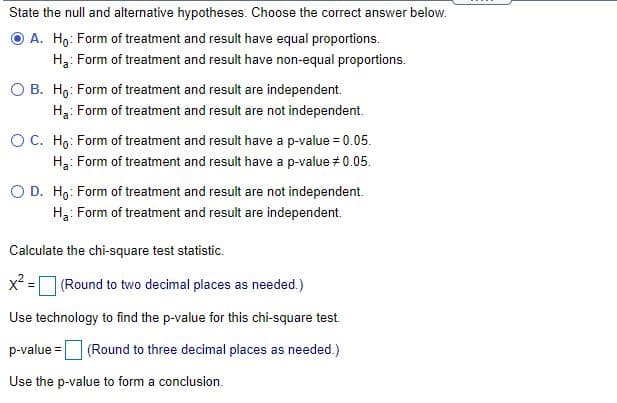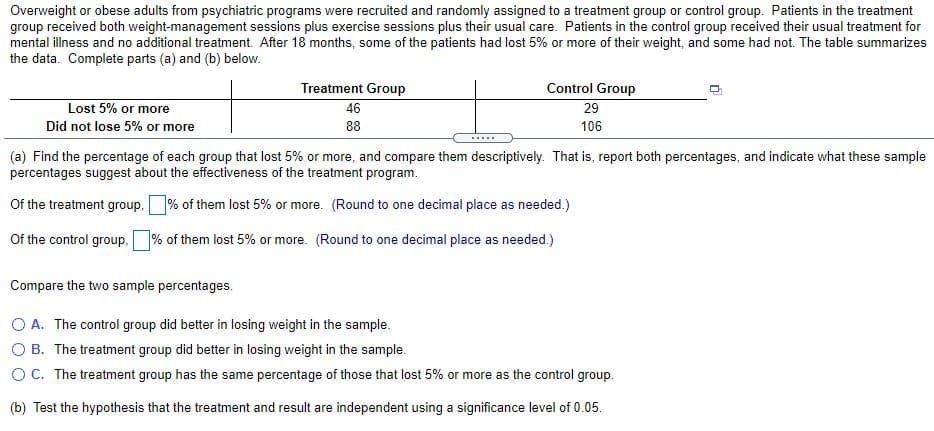Overweight or obese adults from psychiatric programs were recruited and randomly assigned to a treatment group or control group. Patients in the treatment group received both weight-management sessions plus exercise sessions plus their usual care. Patients in the control group received their usual treatment for mental illness and no additional treatment. After 18 months, some of the patients had lost 5% or more of their weight, and some had not. The table summarizes the data. Complete parts (a) and (b) below. Treatment Group 46 Control Group 29 Lost 5% or more Did not lose 5% or more 88 106 ..... (a) Find the percentage of each group that lost 5% or more, and compare them descriptively. That is, report both percentages, and indicate what these sample percentages suggest about the effectiveness of the treatment program. Of the treatment group. % of them lost 5% or more. (Round to one decimal place as needed.) Of the control group, % of them lost 5% or more. (Round to one decimal place as needed.) Compare the two sample percentages.
Overweight or obese adults from psychiatric programs were recruited and randomly assigned to a treatment group or control group. Patients in the treatment group received both weight-management sessions plus exercise sessions plus their usual care. Patients in the control group received their usual treatment for mental illness and no additional treatment. After 18 months, some of the patients had lost 5% or more of their weight, and some had not. The table summarizes the data. Complete parts (a) and (b) below. Treatment Group 46 Control Group 29 Lost 5% or more Did not lose 5% or more 88 106 ..... (a) Find the percentage of each group that lost 5% or more, and compare them descriptively. That is, report both percentages, and indicate what these sample percentages suggest about the effectiveness of the treatment program. Of the treatment group. % of them lost 5% or more. (Round to one decimal place as needed.) Of the control group, % of them lost 5% or more. (Round to one decimal place as needed.) Compare the two sample percentages.
Glencoe Algebra 1, Student Edition, 9780079039897, 0079039898, 2018
18th Edition
ISBN:9780079039897
Author:Carter
Publisher:Carter
Chapter10: Statistics
Section10.6: Summarizing Categorical Data
Problem 23PPS
Related questions
Question

Transcribed Image Text:State the null and alternative hypotheses. Choose the correct answer below.
O A. Hg: Form of treatment and result have equal proportions.
H3: Form of treatment and result have non-equal proportions.
O B. Ho: Form of treatment and result are independent.
Ha: Form of treatment and result are not independent.
OC. Ho: Form of treatment and result have a p-value = 0.05.
Ha: Form of treatment and result have a p-value # 0.05.
O D. Ho: Form of treatment and result are not independent.
Ha: Form of treatment and result are independent.
Calculate the chi-square test statistic.
x² =
(Round to two decimal places as needed.)
Use technology to find the p-value for this chi-square test.
p-value =
(Round to three decimal places as needed.)
Use the p-value to form a conclusion.

Transcribed Image Text:Overweight or obese adults from psychiatric programs were recruited and randomly assigned to a treatment group or control group. Patients in the treatment
group received both weight-management sessions plus exercise sessions plus their usual care. Patients in the control group received their usual treatment for
mental illness and no additional treatment. After 18 months, some of the patients had lost 5% or more of their weight, and some had not. The table summarizes
the data. Complete parts (a) and (b) below.
Treatment Group
Control Group
Lost 5% or more
46
29
Did not lose 5% or more
88
106
.....
(a) Find the percentage of each group that lost 5% or more, and compare them descriptively. That is, report both percentages, and indicate what these sample
percentages suggest about the effectiveness of the treatment program.
Of the treatment group,% of them lost 5% or more. (Round to one decimal place as needed.)
Of the control group,
% of them lost 5% or more. (Round to one decimal place as needed.)
Compare the two sample percentages.
O A. The control group did better in losing weight in the sample.
O B. The treatment group did better in losing weight in the sample.
OC. The treatment group has the same percentage of those that lost 5% or more as the control group.
(b) Test the hypothesis that the treatment and result are independent using a significance level of 0.05.
Expert Solution
This question has been solved!
Explore an expertly crafted, step-by-step solution for a thorough understanding of key concepts.
This is a popular solution!
Trending now
This is a popular solution!
Step by step
Solved in 2 steps with 3 images

Recommended textbooks for you

Glencoe Algebra 1, Student Edition, 9780079039897…
Algebra
ISBN:
9780079039897
Author:
Carter
Publisher:
McGraw Hill

Big Ideas Math A Bridge To Success Algebra 1: Stu…
Algebra
ISBN:
9781680331141
Author:
HOUGHTON MIFFLIN HARCOURT
Publisher:
Houghton Mifflin Harcourt

Glencoe Algebra 1, Student Edition, 9780079039897…
Algebra
ISBN:
9780079039897
Author:
Carter
Publisher:
McGraw Hill

Big Ideas Math A Bridge To Success Algebra 1: Stu…
Algebra
ISBN:
9781680331141
Author:
HOUGHTON MIFFLIN HARCOURT
Publisher:
Houghton Mifflin Harcourt